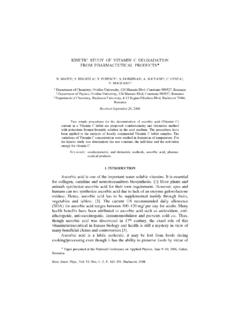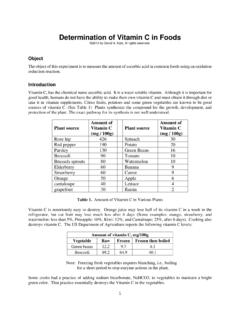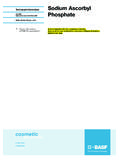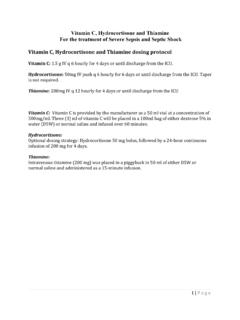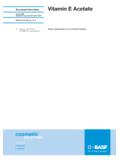Transcription of Stability Studies on Ascorbic Acid (Vitamin C) From ...
1 IOSR Journal of Applied Chemistry (IOSR-JAC) ISSN: 2278-5736. Volume 2, Issue 4 (Sep-Oct. 2012), PP 20-24 20 | Page Stability Studies on Ascorbic acid ( vitamin C) From Different Sources 1 Oyetade, , 2 Oyeleke, , 3 Adegoke, and 4 Akintunde, 1,3,4 Applied Sciences Department, Osun State Polytechnic, Iree, Nigeria. 2 Science Laboratory Technology Department, Osun State Polytechnic, Iree, Nigeria. Abstract: Ascorbic acid (Laboratory grade), grape juice and vitamin C tablet (a pharmaceutical product) were either packaged in different materials or exposed to air or stored at different temperature were used to study Stability of Ascorbic acid using titrimetric analytical method with 2,6-dichlorophenolindophenol. Results of analysis showed that packaging materials, exposure to air and storage temperature condition significantly affected the Stability of the vitamin .
2 A significant negative correlation exists between Ascorbic acid decline and time of storage and of exposure to air. Ascorbic acid content was more stable in the three sources when stored under refrigeration condition (4-50C) as obtained in the investigation. Keywords: Stability , Ascorbic acid , packaging materials, refrigeration condition, exposure, sun. I. Introduction vitamin C, otherwise known as Ascorbic acid content of fruits varies with the type of fruits, exposure to the sun and other growing condition (Franke et al., 2004). It is likely to be higher in early fruits than in late fruit [1]. The Stability of Ascorbic acid decreases with increase in temperature and pH as reported by Emese et al., [2]. This destruction by oxidation is a serious problem in that a considerable quantity of the vitamin C contents of food is lost during processing, storage and preparation [2,3]. Ascorbic acid decreases gradually during storage especially at temperature above 0oC [4].
3 Various ways by which we administer fruits or leafy vegetables containing Ascorbic acid decreases their Ascorbic acid retention, for instance, bruising, peeling, cutting into pieces and exposure to air decreases Ascorbic acid retention [5,6]. Peeling apples may results in the loss of 8-25% of their Ascorbic acid . It is evident that the vitamin C retention of fruits varies with the treatment but in general, fruits are valuable when they are used raw and have the minimum of bruising, cutting, peeling and exposure to air [7,8,9]. Various sources of Ascorbic acid for example, citrus fruits, vegetables and pharmaceutical products (tablets) in Nigeria markets are handled should be of concern to nutritionist. All these sources are exposed to sun during their distribution and marketing. Pharmaceutical products are also not distributed in a way better than that of fruits.
4 They are packaged in different materials ranging from paper, nylon, plastic to bottles of different shades. It appears no concern is shown for the Stability of the active ingredients in such products. The present study aims at investigating the effects of temperature, exposure to air and packaging materials on the vitamin C content of pharmaceutical product ( vitamin C tablet), laboratory grade (pure vitamin C) and grape juice (natural source) with a view to providing useful information towards effective utilization of the vitamin under investigation. II. Materials and Methods Collection and Preparation of Samples Pharmaceutical product ( vitamin C tablet) used for this research work were obtained from Borepo Pharmacy Store, Osogbo. The natural source (Grape juice) were collected from Akanle's farmland in Odeomu, Osun state while the pure source (laboratory grade of vitamin C) were obtained from the Chemistry Laboratory, Department of Science Laboratory Technology, Osun state Polytechnic, Iree, Nigeria.
5 All the samples were collected same day and used to study the effect of temperature, exposure to air and packaging materials on the vitamin C content of the different sources Effect of Temperature Different sources of vitamin C were maintained at varying temperature conditions refrigeration (4-5oC), 350C, 55OC, 750C and 950C for a maximum of 240 minutes. vitamin C content was estimated at the beginning of the experiment and subsequently at 60 minutes interval. Effects of Exposure to Air Different sources of vitamin C were left in open in the laboratory at room temperature for a maximum Stability Studies On Ascorbic acid ( vitamin C) From Different Sources 21 | Page of 240 minutes during which vitamin C content was determined at regular interval of 60 minutes. Effect of Packaging Materials Only pharmaceutical product was subjected to this test.
6 The vitamin C tablet was packaged in paper (white and brown) and nylon envelopes and in bottles (transparent and brown) for a maximum period of 20 days. the vitamin C content was assayed at interval of 4 days. Analytical Procedure vitamin C content in the experimental design above were assayed using titrimetric analysis with 2,6- dichlorophenolindophenol (AOAC, 1990). All determinations were done in triplicates and results obtained were subjected to analysis of variance and regression analysis in accordance with the procedure of Stell and Torrie (1980). III. Results and Discussion Table 1: Effect of packaging material and storage time on Ascorbic acid contents of vitamin C tablet (a brand of pharmaceutical products) in mg/tablet. Storage time (days) Packaging Material 0 4 8 12 16 20 SEM Bottle Brown Transparent Envelope Nylon White Paper Brown Paper *Means are denoted by different subscripts in a column are significantly different at P ( ) Stability of Ascorbic acid in vitamin C tablet packaged in different materials is presented in Table 1.
7 The results indicated a significant influence of packaging materials on Stability of Ascorbic acid irrespective of the packaging materials, there was a significant negative correlation between length of storage and the Ascorbic acid content. The relationship is described by the regression equation shown in Table 2. Table 2: Regression line showing the relationship between Ascorbic acid and the different parameters Parameter Regression line+ r -value t-value Storage time(days) Y= * Time of exposure to air (min.) Y= * Holding time (min) at refrigeration 4-50C Y= 350C Y= * 550C Y= * 750C Y= * 950C Y= * +Y: Ascorbic acid content (mg) *: significant at P ( ) X: Parameter : not significant at P ( ) The result also indicated that vitamin C was significantly higher at zero than at between the fourth and twenty day. It therefore suggested that there was a rapid loss of vitamin C initially which later stabilized as from the fourth day and is graphically represented in Fig.
8 1. Similar result of vitamin C Stability packaged in different materials tended to suggest that light had no significant effect on the vitamin . Table 3: Changes in Ascorbic acid contents of different sources exposed to air at room temperature Sources Exposure time (min) Tablet (mgAA/tablet) Grape-Juice (mgAA/100ml) Laboratory Grade vitamin (mgAA/g) 0 *a 60 120 Stability Studies On Ascorbic acid ( vitamin C) From Different Sources 22 | Page 180 240 SEM AA- Ascorbic acid ( vitamin C), * means (denoted by different subscripts in a column) are significantly different at P ( ). Table 3 depicts changes in Ascorbic acid content of different sources exposed to air at room temperature and is graphically represented in Fig 2. The results of analysis indicated that there was marked reduction in the Ascorbic acid content of the sources with length of exposure.
9 The negative correlation between both variables is described by regression equation shown in Table 2 above. The result also indicated that while a significant reduction in Ascorbic acid contents was noticed within 60 minutes of exposure in tablet and grape juice no such significant change was observed in the laboratory grade until 120 minutes. However, rapid loss of the vitamin was noticed at 180 minutes of exposure. For tablet and grape juice, rapid losses was noticed at 240 minutes respectively. The delay in the rapid loss of this vitamin in the tablet may be due to small surface area exposed or presence of binder which probably must have been added during manufacturing. On the other hand, the juice and the laboratory grade vitamin C, have more surface area for exposure and at the same time have no protector. Table 4: Changes in Ascorbic acid contents of different source stored at either refrigeration condition or exposed to different temperature Storage Condition Source/holding time (min) Refrigeration (4-50C) 350C 550C 750C 950C Tablet 0 60 120 180 240 SEM Grape Juice 0 60 120 180 240 SEM Laboratory Grade 0 60 120 180 240 SEM Effects of storage temperature on the Ascorbic acid content of the different sources are shown in Table 4 and the result is graphically represented in Fig 3, 4 and 5.
10 The result indicated that with the exception of the tablet stored under refrigeration condition, Ascorbic acid was affected by storage time, in all cases there was Ascorbic acid reduction. Indeed there were negative correlation between holding time and Ascorbic acid content at different temperature (Table 2). However, the negative correlation between the variables was not significant under refrigeration condition. This result therefore is suggestive of refrigeration condition for storage of vitamin C source. IV. Conclusion The results of the analysis showed that packaging materials, exposure to air and storage temperature condition significantly affected the Stability of the vitamin . It was observed that a significant negative correlation exist between Ascorbic acid and time of storage and exposure to air and Ascorbic acid was more stable in the three sources when stored under refrigeration condition (4-50C).










